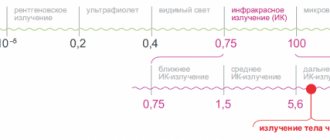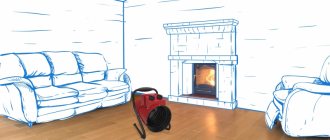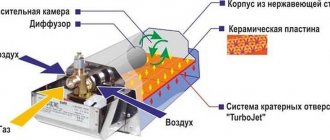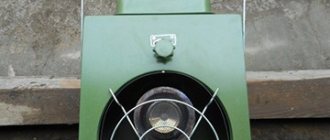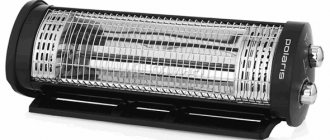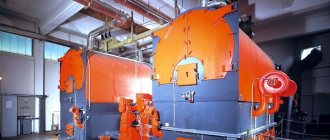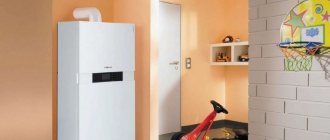Operation of infrared heaterscolor
Operation of infrared heaters
– the order of operation of heat-generating devices that convert consumed energy into heat, which is transferred to objects via infrared radiation.color>
Operating principlecolor>
The operating principles of infrared heaters are significantly different from any other types of heating devices. Its functioning is associated with the generation of thermal energy in a wide spectrum of infrared radiation. Moreover, the maximum value of the radiation intensity in this spectrum falls on a wavelength proportional to the heating temperature of the radiating body. Thermal energy is delivered to the required location by electromagnetic waves at a speed of about 300,000 km/sec. In this regard, infrared heating differs from other types in that the delivery of infrared heat occurs almost immediately after the heater is turned on. Conversely, the effect of heat rays stops when turned off. There is no fundamental difference: turning on or off a light source or a heat source in a room.
The operation of infrared heaters is based on the fact that infrared radiation primarily heats objects that are in its path. The air practically does not directly receive heat from the infrared ray; it passes it through itself. Objects, gradually heating up by convection, transfer heat to the air. With this heating method, objects located in the zone of infrared radiation will always be 2 - 3 ° C warmer than the air. The effect of infrared heaters is that the thermal energy generated by them is 90% spent to heat objects and only 10% is directly absorbed by the air mass, so they have high efficiency. All other types of heaters spend the bulk of the energy consumed on heating the air and only from it do all other objects heat up. Due to the fact that the infrared ray is almost not absorbed by the air and does not reduce the oxygen content in it, comfortable conditions for human stay are created. At the same time, he does not experience such sensations as lack of oxygen, headache, general malaise and fatigue, which are inherent in staying in a room heated by convection heaters.
Features of applicationcolor>
This type of heater is widely used in creating local heating zones for workplaces in industrial enterprises and is the only way to heat a person in rooms with large ceilings and heat losses. The use of infrared heaters makes it possible to create a local heating zone with a spot diameter approximately equal to (2 * h), that is, equal to two heights of the emitter suspension. At the same time, the heat transfer area is much larger than that of conventional heaters, which means the heating time is reduced. Reducing the heater operating time leads to energy savings. Therefore, infrared heaters today are the most efficient electric heating devices, allowing energy savings of about 50% of the calculated power. They have found wide application in heating houses, cottages, garages, industrial premises, etc.
Heat pump principle
With infrared heating, losses still exist, although manufacturers use very effective heat reflectors, which allow the bulk of the heat flow to be directed directly. To reduce losses, a type of heater is required so that it directly transfers heat to the floor of the room. And such a device exists - it is a heat pump. True, in industrial premises it will work effectively only if a system of underfloor heating or floor convectors is used, which allows the formation of convection flows as low as possible.
The beauty of a heat pump is that it does not create heat, but only converts low-calorie heat from some natural coolant - for example, deep layers of soil. And as such, energy is required only for the circulation of coolant in the system. Therefore, this heating method will always be the least expensive. Let's say, with an output thermal power of 6 kW (which is enough for 60 square meters of area), such a pump consumes about 2 kW of electricity - such efficiency cannot be achieved even with the most advanced infrared heaters.
Types of infrared heaters for large rooms
The most common infrared heaters are gas and electric, each of which has several types. The main advantage of all infrared heaters is their efficiency.
Compared to a conventional heating system, infrared heaters will be twice as economical, and when installing a new infrared
equipment, it pays for itself in 1-2 heating seasons.
Gas IR heaters
IR gas heaters are mounted on the ceiling and run on gas. They are divided into two types: light and dark. The selection and calculation of power is based on the volume of the heated room, the presence of air flows and the required heating temperature. The disadvantages for gas IR heaters are: the presence of a gas pipeline system, additional installation of an air vent, and a ceiling height of at least 4 meters.
Electric IR heaters
Infrared heaters with ceramic emitters can be installed both on the wall and on the ceiling. They can be used in any type of premises, including outdoors, which is convenient for short-term work outdoors. IR heaters are mounted in any convenient place and connected to the mains.
The advantages of IR heaters are that they can be used in rooms with a high fire hazard, in dusty and damp rooms, they are mobile and can be reconnected within 5-10 minutes. Infrared heating is safe and economical. IR type heaters can be found in hospitals and educational institutions. They are economical and multifunctional.
You can calculate the power of infrared heaters yourself or with the help of a heating specialist from the Infratorg company.
How the heating system is built
The heating system should be made from infrared heaters in such a way as to take into account the parameters of the devices themselves. It is necessary to think over a whole network of such devices. For example, in what quantity should they be used for a particular room, at what height from the floor should they be mounted, at what distance from each other should they be placed, and what should they be powered with. Gas installations serve well both with bottled and main fuel supply. It’s easier with electrics - heat emitters are connected to the electrical network with a preliminary calculation of the load on it.
During work, people who are indoors under the influence of thermal infrared heating can receive heat not only from directly operating devices, but also from heated objects. The temperature of reflected radiation from heated surfaces will be felt by a person to be 1-2 degrees higher than from the heater itself . This suggests that for workers to feel comfortable, it is possible to reduce the power of the main heating device to +15 degrees.
What is an infrared heatercolor
Infrared heater
– - a heating device that uses infrared radiation in its operation and is used for primary or additional heating of premises, as well as local areas of outdoor space or workplaces in the workshop.color>
Heaters are usually used for heating rooms. Depending on the method of heat transfer, they can be convective or radiant. Convective ones work on the principle of mixing cold and hot air, and the difference in temperature of the air mixture on the ceiling and floor can reach large values. Radiant ones transfer heat mainly due to infrared radiation; they are placed above the heated area or on the ceilings and walls of the room.
Air, if it is not saturated with water vapor, almost completely transmits radiant energy. This energy directly heats any objects in its path, and they, in turn, give off heat to the air. Which gives a significant economic effect compared to convection heating, which uses part of the generated heat to heat the under-ceiling space where it is not needed. In addition, infrared radiation is felt by a person immediately after it is turned on, which eliminates the need to preheat the room and can significantly reduce heating costs.
Infrared heater devicecolor>
The main design element of an infrared heater is an emitter that generates infrared radiation. In order to ensure directional radiation and protect the housing from overheating, a reflector made of a heat-resistant element is placed behind the emitter. The reflector on the reverse side is covered with heat-insulating material, which further protects the housing from exposure to high temperatures. If the heater is used in places where people or animals are located, the emitter is covered with a metal mesh to prevent involuntary burns or electric shock.
Infrared wavelengthcolor>
Infrared Wave Range
is an electromagnetic wave located in the emission range from 0.74 microns. up to 2000 microns.color>
Infrared heaters are heating devices that provide heat transfer from a high-temperature emitter to bodies with a lower temperature through electromagnetic (infrared) radiation. Infrared radiation is absorbed by surfaces encountered in its path, turning into thermal energy, and the air is heated from these surfaces. This allows you to significantly save energy on space heating compared to convection heating. The wavelength of the infrared radiation range depends on the heating temperature of the emitters installed in infrared heaters. It is in the range from 0.74 microns. up to 2000 microns. The dependence of the wavelength of infrared radiation on temperature expresses Wien's displacement law. A graphical representation of this law for various temperatures is shown in the figure. It can be seen from the graph that the surface area under the curve relating to a certain temperature is proportional to the amount of radiant energy, and it increases greatly with increasing temperature. In addition, we can conclude that the wavelength λ
at which the maximum value of the curve is determined shifts by smaller values with increasing temperature.
Public and commercial establishments
Infrared heating systems are relevant in administrative, medical, and educational institutions. Their harmlessness allows such equipment to be installed in schools, hospitals and kindergartens. Modern stylish devices, film heaters and panels are perfect for hotels, cinemas and theatres, exhibition halls, cafes and restaurants, shopping, entertainment, sports and health centers.
They not only heat the premises and provide a healthy atmosphere, but can also be an effective element of the interior, increasing the prestige and attractiveness of the establishment. Absolutely unique equipment that helps maintain heat in the open areas of cafes and restaurants, terraces, gazebos or just on the street during a picnic are outdoor infrared heaters
, creating a cozy atmosphere within their range even when cold weather sets in.
It is difficult to find an area where this innovative equipment cannot be used. It is suitable for rooms of any size and any purpose, performs its tasks discreetly and efficiently, and brings significant savings during operation. A large assortment and varied design allows you to purchase an infrared heater
the required power and suitable design, and the costs of such a purchase will very quickly pay off due to a significant reduction in heating costs.
Infrared heating systems system based on infrared emitters
The basis of an infrared heating system is infrared heaters. The principle of their operation is based on the fact that the energy of burned gas or electricity is converted into thermal radiation energy.
Advantages: the ability to target heat to the desired zone and heat individual local zones on a large scale.
Disadvantages: if it is necessary to warm up the entire volume of air in the room, the efficiency of the devices is greatly reduced; radiating surfaces heated to high temperatures are located directly in the heated room, which can lead to a fire; emitters running on natural gas require a complex and extensive gas supply system, which greatly increases the cost of the entire project; Gas-powered emitters burn oxygen from the room, which leads to the need for ventilation; emitters running on electricity consume a lot of electricity, which is uneconomical; Possible deterioration in the well-being of personnel exposed to direct radiation.
Emitters are effective only when in a large volume room it is necessary to heat up several local working areas in a targeted manner; the effectiveness of their use for heating the entire volume of the room as a whole is extremely low.
Industrial infrared heaters IkoLine.
IkoLine infrared heaters with a power from 2.0 to 4.0 kW are conventionally called industrial
. because most often they are used in various industrial premises, workshops, car service centers, warehouses and other premises with ceiling heights from 3.3 to 12.0 meters.
There are, of course, residential premises with high shelves where it is advisable to use more powerful industrial infrared heaters, but such cases are rather the exception.
If you want to create comfortable and economical heating for your production, workshop or warehouse, then IkoLine industrial infrared heaters are the best choice for you. IkoLine industrial infrared heaters are also successfully used in gyms, indoor tennis courts, concert halls and stages, and train stations. In addition to being very efficient and economical, IkoLine heaters are also very easy to use and durable. And of course, an important factor is the low cost of these heaters with high quality. The warranty period for industrial infrared heaters IkoLine is 5 years! Service life 25 - 30 years!
“Is there a fireplace in your house? No, our owner saves on buying firewood.
. take a blanket and sit by the window on the sunny side"
A production facility is a structure that has an area that can rarely be designated in square meters by a three-digit number. Usually this is a four- or sometimes five-digit figure. The height of industrial premises usually starts at 6 meters, reaching 25 meters or more. How to heat an industrial building. with this question, we are usually interested in the heat in the lower part of the room. That is, where people work and production equipment is located. Conclusion: in most cases, thermal comfort is required at a height of 2-3 m from the floor level.
Types of infrared industrial heaters
Let's see what infrared industrial heaters for industrial premises are. To begin with, they are divided according to the type of fastener - there are wall, ceiling and floor. Wall-mounted models are designed for small spaces. They are mounted on walls at a height of 2.5-3 meters and are most suitable for buildings of limited volume and small area.
For uniform heating, IR heaters should be placed at an equal distance from each other.
Ceiling-mounted industrial air heaters are designed for large areas. They are characterized by high power, so they are mounted at high heights, on suspensions or cables. Such devices are quite popular and the most convenient - they have great power, do not interfere with anyone, and eliminate the risk of burns.
The floor-mounted industrial IR heater is the rarest type of heating equipment. A device of this type is a tripod or a single stand with emitters attached to them. Purpose: spot heating.
The next division of industrial infrared heaters is based on the type of power supply. Industrial gas heaters operate using liquefied or natural gas. They are equipped with miniature burners with automatic ignition. They heat metal or ceramic emitters, as a result of which they begin to generate infrared radiation that is sent into the room.
Gas industrial infrared heaters are divided into dark and light. In the dark, the combustion process is hidden; it occurs in a sealed pipe through which air is supplied. IR radiation is emitted using fin emitters. The combustion temperature in the system does not exceed +400 degrees.
Light infrared industrial heaters operate at higher temperatures - they are equipped with high-temperature burners that produce flames with temperatures up to +1000 degrees. Compared to dark devices, they are lighter, so they can be used in pre-fabricated buildings where various restrictions apply.
Air heating installation
Heating of production workshops
Having a clear plan for the location of components and assemblies of the system, it is very easy to carry out installation work by the company’s employees. However, if you wish, you can contact specialized companies
When installing it yourself, first of all, you need to pay attention to the completeness of the delivery. Manufacturers supply air ducts, dampers, inserts and other standard elements to order
In addition, you can additionally purchase the following materials:
- flexible lines
- aluminum tape
- insulation and mounting tape
Insulating some areas is very important because it helps prevent condensation. For this purpose, a layer of foil insulation on a self-adhesive base is laid on top of the pipeline walls.
Its thickness may vary. The most in demand are materials with a thickness of 3-5 millimeters.
Depending on the geometry of the premises and the design solution, rigid or flexible lines are installed. Individual sections are connected to each other using reinforced tape, plastic or metal clamps. All installation work boils down to performing the following set of actions:
- installation of warm air supply lines
- installation of distribution sockets
- installation of a heat generating unit
- laying a thermal insulation layer
- installation of additional equipment
Air heating in warehouses. production and utility rooms is a complete heat supply system. It is characterized by efficiency and high efficiency.
Criteria for selecting contractors for the development of a heating system for industrial premises
The right choice of a contracting organization that can quickly and efficiently cope with such a difficult task as organizing optimal heating of production is 99% of success.
One of the fundamental criteria is formal – the Contractor’s membership in a specialized SRO (self-regulatory organization).
Such non-profit partnerships were created within the framework of legislation in 2009. Previously, the obligatory basis for carrying out work was the presence of an appropriate Rostechnadzor License.
Now such a criterion is membership in one of the SROs
If the Contractor is included in it, it means that he has the appropriate legislative framework, human, material resources and production base necessary to carry out contract work even on such a scale as heating factories professionally and on time. Often this factor is not given attention, and yet an organization that is not a member of the SRO does not have the right to take on such contracts
The second criterion can be called the company’s experience, both in the engineering market in general and in the segment under consideration in particular. Even the presence of all permits and qualified specialists does not guarantee high quality results.
As we have already written, this topic has many specific nuances. Inexperienced companies may simply not know about them or imagine them by hearsay, and have a superficial knowledge of the topic.
Everyone gets into trouble at some point... But you want them to be “hit” not on you, right?
Another important parameter is the number and structure of the company, as well as the qualifications of its employees. If the company is a member of the SRO, it meets the minimum requirements
But when we are talking about such an important and large-scale project as industrial heating, the minimum acceptable level is, as a rule, not enough. Therefore, it is advisable to familiarize yourself with the potential capabilities of the future Contractor in advance.
The next significant criterion is the presence of a clearly structured system for performing work and a model for managing it. Its influence on the result, it would seem, is less obvious than the parameters indicated above, but, nevertheless, many cases are known when experienced companies with competent technical workers, who approached the task quite conscientiously, “failed” the Object.
The main reason is the lack of a systematic approach to performing this work, insufficiently effective management of business processes, and the lack of a quality control system.
Finally, the level of business and personal contacts of the company with suppliers and subject knowledge of the equipment used are also important. It is no secret that, for example, heating factories is a very resource-intensive and expensive project, so the success of the result depends on how high-quality and appropriate the equipment is selected and supplied, how quickly it is delivered and installed. Overlays in this process are fraught with high costs.
In addition, the possibility of further service also plays an important role, which also depends on the level of the contractor’s relationship with suppliers and manufacturers of heating equipment.
The price level for equipment from a company with established business connections will always be lower than that of a newcomer to this business. This is due to the size of the discounts provided by manufacturers and distributors. Accordingly, a company with large discounts can offer better conditions to its Customers.
We, as a member of a specialized SRO, have been working in this area since 1999. Our structure has a powerful engineering staff, a qualified design department, as well as experienced installation teams. The staff of specialists is divided into those who work in the industrial segment and those who deal with the domestic segment - heating country houses.
Each Object is assigned an experienced manager-coordinator. The work is carried out through multi-stage control at all stages.
Our established direct contacts with manufacturers of equipment and materials allow us to complete Objects quickly and at attractive prices.
Are you looking for a reliable Contractor for heating industrial premises and workshops? We guarantee that our cooperation will be pleasant, free of headaches, and mutually beneficial!
How to choose heating for an industrial premises?
“How to choose the optimal heating”? – this is the question asked by the owners of production facilities, workshops and warehouses. The large size of buildings, combined with the harsh climatic conditions of Russia, frighten young entrepreneurs. In this review we will talk about “optimal” heating. First, let’s figure out what is meant by the word “optimal.” Usually this word is understood as a suitable ratio for a building “cost/reliability/convenience”.
Selecting and creating a heating scheme for large rooms is not an easy task. Each building is universal – size, height, purpose. Production equipment is often an obstacle to laying pipes. But without heating there is nowhere. A well-built heating system protects equipment from hypothermia (often this is the factor that leads to equipment breakdown) and creates favorable working conditions for workers. In addition, without the required temperature, some products will spoil much faster. This is why it is so important to choose a reliable heating system.
Choosing a heating system for industrial buildings
Almost every warehouse needs heating. Centralized heating systems are usually used. They are:
- Water;
- Airborne.
When choosing heating, the following characteristics should be taken into account:
- Area and height of the building;
- The amount of heat energy required to maintain the desired temperature;
- Lightness of heating equipment in technical terms, its wear resistance.
Next we will talk about the pros and cons of the above-mentioned types of heating for industrial premises.
Central water heating
The main thermal resource is the central heating system or boiler room. Water heating includes:
- Boiler;
- Heating appliances;
- Pipeline.
The operating principle is simple. The liquid is heated in the boiler and goes through the pipes, giving off heat.
Types of water heating:
- Single-pipe (water temperature cannot be adjusted);
- Two-pipe (temperature regulation is possible. It is carried out using thermostats on radiators).
The central heating element is the boiler. Today there are quite a few types of boilers: liquid fuel, solid fuel, gas, electric and mixed. You should choose a boiler taking into account the possibilities. A gas boiler is convenient when you can connect to a gas source. It should be taken into account that the price of this resource increases every year. Gas supply interruptions will lead to dire consequences.
Liquid fuel boilers require a separate room and container for storing fuel. In addition, fuel supplies will need to be constantly replenished, which means additional hands are needed for transportation and unloading. And these are additional costs.
Solid fuel boilers are not suitable for heating large industrial premises. Caring for a solid fuel boiler is not an easy task (loading fuel, cleaning the chimney and firebox). On the modern market you can find partially automated models with the possibility of automated fuel loading. Other components (firebox, chimney) require human care. The fuel is sawdust, pellets, wood chips, etc. Despite the fact that operating such boilers is a labor-intensive process, these models are the cheapest on the market.
Electric boilers are not the most suitable option for heating large rooms (up to 70 square meters). The electricity used will cost the owner dearly. It is worth considering that planned and unscheduled power outages negatively affect the system.
Combination boilers can be called universal models.
A water heating system provides stable and efficient heating of the room. Despite the fact that combined boilers cost more than their counterparts, but with it you will not depend on external troubles (various interruptions in gas and electrical systems). Combined boiler samples have two or more heaters for different types of fuel. Thanks to the built-in types of burners, boilers are divided into:
- Gas-wood - not afraid of interruptions in the gas supply system and rising fuel prices)
- Gas-diesel - ideally heat a large room)
- Gas-diesel-wood - a functional boiler with low efficiency and low power)
- Gas-diesel-wood-electricity is an almost universal unit that is completely independent of external problems
The situation with the boilers has been clarified. Now you need to find out whether the water type of heating meets the previously described criteria. It is worth noting that the heat capacity of water is thousands of times higher than the heat capacity of air. This means that you will need thousands of times less water than air. Another point: a water heating system will allow you to set the desired temperature at different times. For example, during normal production heating the temperature will be +10 C, but during working hours you can set a higher temperature.
Air heating
People have been using air heating for a long time. The system is effective and popular. Has the following advantages:
- Air ducts are installed instead of radiators and pipes.
- Air heating has higher efficiency compared to a water system
- The heated air is evenly distributed over the entire area of the room
- It is convenient to connect the air system with ventilation and air conditioning (you can get clean air instead of warm air)
- Constant change of air has a positive effect on the well-being of workers; work efficiency increases.
If you want to save money, it is better to choose mixed air industrial heating. It consists of natural and mechanical air stimulation.
- The "natural" urge is to take in the warm air of their atmosphere at any temperature.
- Mechanical impulse is the intake of cold air by the air duct for its subsequent warming and supply to the room.
It is believed that an air heating system is the best option for heating large industrial premises.
Infrared heating
It is possible to heat an industrial premises using non-traditional methods. Infrared heaters are a modern invention of engineers. The principle of their operation is as follows: emitters produce energy above the heating zone and transfer heat to objects that heat the air. The functionality of such heaters is compared to the sun. It also heats the surface of the earth using infrared waves, and then the air is heated by heat exchange. Thanks to this principle, heated air will not accumulate under the ceiling, being evenly distributed over the area of the room.
There are many types of IR heaters, differing in the following characteristics:
- Installation location (floor, portable floor, wall, ceiling);
- Type of emitted waves (short-wave, medium-wave and light);
- Type of energy consumed (diesel, gas, electric).
The most profitable are gas and diesel infrared heater models. Their efficiency is often above 90%. But they are characterized by burning air and changing the characteristics of its humidity.
- Type of heating element (halogen - not very durable models; carbon - fragile model, but consumes less energy; ceramic - the heating device is assembled from ceramic tiles. Inside it is a mixture that heats the environment).
IR heaters are used for heating industrial buildings, various structures, work shops, greenhouses, greenhouses, farms and apartments.
Benefits of infrared heating
IR heating can provide spot heating, that is, different parts of the building can have different temperatures. Infrared heaters do not come into contact with air, heating surfaces, objects, and organisms. This means there will be fewer drafts in the room. IR heating is economical. High efficiency and low power consumption are just a dream. Long service life, ease of installation, light weight, and the possibility of local effective heating are just the main positive aspects of IR heaters.
In this extensive article, we looked at popular types of space heating. Which type is the most optimal is up to you to decide. We hope that this article was useful and complete information.
Types of heating devices
Today's realities show that infrared heating is in sufficient demand, so equipment manufacturers are trying to approach the manufacturing issue carefully. Depending on the purpose, the types of heating devices powered by infrared healing can be divided into the following types:
- heaters. Almost everyone is familiar with a device with a lamp, often equipped with an additional support. Such devices are good for gatherings on the terrace or in the gazebo. They can also be used to heat private buildings and even greenhouses;
- lamp devices. Lamps with IR radiation are not much different from heaters, except for the installation method. They are attached to the ceiling at a certain angle. Thus, large production premises and workshops are heated;
- panels. Panel equipment powered by infrared radiation is probably the most reasonable solution for heating a home. A beautiful smooth surface, sometimes with a chosen design, fits perfectly into the overall interior and does not create any special problems for residents;
- film. There is also a film type of device. This is an indispensable basis for obtaining heat in the house based on the “warm floor” technology. But when installing equipment, it is quite acceptable to place it on the walls of the room.
In general, infrared heating has a number of advantages. It operates silently, does not create dust or deposits on surfaces, and does not take up storage space.
Infrared heater
Advantages and disadvantages
The air heating method has undeniable advantages:
- The efficiency reaches 93%. When organizing heating, the installation of intermediate heating devices is not required.
- Heating systems of this type can be fully integrated with ventilation systems. This allows you to constantly maintain an optimal microclimate inside production complexes.
- Very low level of inertia. Immediately after activating the equipment, the air temperature in the room begins to rise.
- High efficiency has a positive effect on the economic performance of production and reduction in production costs.
Along with this, air heating also has obvious disadvantages:
- Constant technical maintenance of the active elements of the system is required. It is quite difficult to modernize already operating installations.
- To avoid interruptions in heat supply, a backup power source is required.
Are IR heaters harmful to industry?
Air heating of workshops and factories using infrared gas and electric types, provided that the system is correctly selected and recommendations are followed, is completely safe for people and the environment. Short-wave emitters can cause harm to humans. It is also necessary to strictly observe the proper installation of IR systems in the production area. Usually the manufacturer marks a dangerous installation location. If all safety requirements are met, IRs are considered safe and have a positive effect on humans. In terms of their technical parameters, IR emitters have no analogues.
YouTube responded with an error: The request cannot be completed because you have exceeded your quota.
- Related Posts
- How to organize infrared heating at home?
- Is there any health risk from infrared heating at home?
- Advantages of heating with infrared heaters
- What are the pros and cons of infrared heating?
- How to calculate infrared heating?
- How is film infrared heating installed?
Choosing a system for heating industrial premises
Heating of industrial premises is carried out using different types of systems, each of which requires detailed consideration. Centralized liquid or air systems are the most popular, but local heaters can also often be found.
The choice of heating system type is influenced by the following parameters:
- dimensions of the heated room;
- the amount of thermal energy required to maintain the temperature regime;
- ease of maintenance and availability of repairs.
Each system has its pros and cons, and the choice will primarily depend on the compliance of the functionality of the selected system with the requirements that apply to it. When choosing the type of system, it is necessary to calculate the heating system of an industrial building in order to have a clear understanding of how much heat the building needs.
Types of IR gas heaters
Infrared ceiling electric heaters for production sites are divided into two groups:
- light emitters - designed for heating factories with a ceiling height of at least 4 meters. Such models are one of the most productive and powerful in their segment. Thermal power calculation is carried out taking into account that for every 20 cubic meters a power installation of 1 kW is required. 5 kW mounted heaters will quickly cope with heating 100 cubic meters. The method of operation of the device is to absorb a gas mixture and air in a special burner at a temperature of 800-1000 degrees. A gas outlet channel is used to eliminate combustion products;
- dark emitters - the process of gas absorption is carried out at a temperature of 350-400 degrees. As a result, the metal tube, which is the emitter, does not glow red-hot, which contributed to the reason for the name of the heating devices. When fixing heaters of this type, you need to take into account that the emitters are larger in size than their light-colored counterparts. For factories and workshops, light or dark type devices are chosen. The choice depends on the technical characteristics of the building itself and the type of production activity.
We recommend: How is film infrared heating installed?
